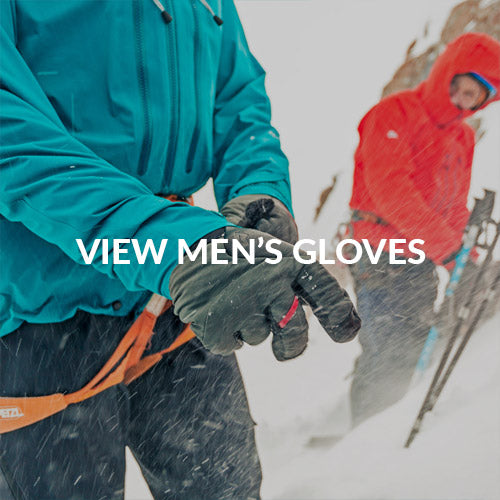Gloves For Winter Climbing, Hot Aches & Anubis (Scottish XII, 12)
- Our Team & Partners


In this follow-up blog to his earlier Guide to Winter Gloves, Dave MacLeod talks about some of the benefits of having more than one pair of gloves in your winter armoury, and why it’s so important to have the right gloves for winter climbing. He also discusses his first ascent of Anubis, (Scottish XII, 12), Ben Nevis, as a case study of why hot aches are always imminent if not thoroughly prepared with the right pair of gloves.
Dave’s Glove Standard
The very best waterproof gloves, be they GORE-TEX® or otherwise, and almost any good quality mountaineering gloves can appear relatively expensive these days. However, the argument in favour of their cost is at least as strong as any other piece of kit in your armoury. In winter climbing, speed is safety.
With cold hands, every one of the hundreds of tasks you must perform on a winter climb goes slower. And this is usually most accentuated at key moments in the day when you’d give your teeth to complete the task faster. For instance, excavating belay or abseil anchors under snowed-up rock in failing light at the end of the day can be critical to getting off the climb before dark, exposure to avalanche danger, or a night time storm/navigation epic. Every minute counts here.
Of course, one way to ensure dry and warm gloves for crucial moments in the day is just to carry more of them. How much this adds to your weight burden calculus depends on the place and conditions on the day, but spare gloves are a seriously good idea if you can carry them (which you nearly always can).

Always Carry The Right Gloves For Winter Climbing
I’ll take a winter day on Ben Nevis as my obvious example. I’ll carry two pairs of Super Couloir’s and one (occasionally two for long routes) pair of Direkt Gloves. I start off the approach with no gloves since there’s no point soaking a pair from the inside with sweat. But I’ll keep them handy to put on at some point on the approach, when the wind picks up or I’m using an ice tool on approach snow slopes.
I choose the warmer GORE-TEX® pair (the Super Couloir’s) for this job since I’m most likely to be exposed to wet snow (or rain!) lower down, and holding an ice tool by the metal head while moving over easy snow transmits more cold than the rubber handle used for the real climbing.
If I’ve not sweated into this pair too much, I’ll stick with them for any ‘easier’ pitches on the climb up to around grade VIII. For crux pitches, I’ll have the Direkt gloves stowed inside my Tupilak jacket, pre-warmed for the hardest pitch. But I’ll only put them on if the hardest climbing is right off the belay. Otherwise I’ll start the pitch in the Super Couloir’s and change them at a suitable point right before the hardest climbing kicks off. That said, if the weather is truly foul, I’ll happily keep the Super Couloir’s on for Scottish XI or even harder. I just might take a bit longer to place the gear.
If we are leaving rucksacks at the base of the climb, for a hard Scottish mixed route we’ll generally take a small (12-15 litre) ‘pig’ sack for the second to carry with food, water belay jacket and our spare Super Couloir gloves. On long routes with multiple hard pitches, the extra pairs are nearly always used and feel like a total lifesaver which not only speeds things up but also greatly restores morale when the day’s adventure is starting to feel a touch ‘out of hand’.
Anubis (Scottish XII, 12) on Ben Nevis

Once in a while though, there is a situation when you just have to rely on a single pair, and climbing demands that they be the lightest pair you can safely wear. On the first ascent of Anubis (Scottish XII, 12) on Ben Nevis, I’d previously failed on the route three times for no other reason than getting pumped and running out of steam on the grossly overhanging crux. I understood that weight was critical and so I ditched everything I possibly could – a mid-layer, a good bit of my normal rack, and a spare pair of gloves for the easier upper half.
On the day of my ascent, my climbing partner was not going to be able to second me, so my plan was to pull up my ropes after the crux first pitch (which took me 5 hours to lead), tie the ends together and drop them back down, and then continue in a single 120 metre pitch. When I reached the end of the rope I untied and dropped the ropes and continued solo, returning to retrieve my runners the following summer.
It was a bitterly cold day with temperatures of minus 10c. On snowy grade 3 terrain on the upper pitches, my damp hands were like ice cubes as I plunged them into the snow to find placements. But my body was warm from the exertion of the last few hours and I knew a memorable bout of hot aches was imminent. I could feel they would be so bad that I was worried about passing out, which would not be good in a solo situation.
So I dug a huge bucket seat in the snow and plonked myself in it and had the peculiar experience of suffering 20 minutes of mind-bending agony while perched solo in the middle of the face. After the blood had returned, I picked myself up and continued. A few years later, trying prototype Direkt gloves on for the first time, my mind was immediately drawn back to this sharp memory burned in my mind. At least I’ll have them for the next Anubis.







